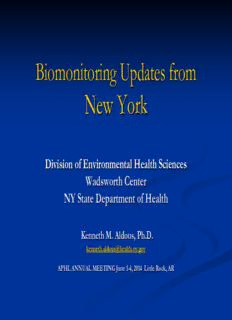
21 Aldous PDF
Preview 21 Aldous
Biomonitoring Updates from New York Division of Environmental Health Sciences Wadsworth Center NY State Department of Health Kenneth M. Aldous, Ph.D. [email protected] APHL ANNUAL MEETING June 1-4, 2014 Little Rock, AR Biomonitoring The Next Five Years? Where to focus efforts for the next five years? Review what has been accomplished during the last five+ years. New ideas for advancing the field of biomonitoring How to continue building a national biomonitoring network or system Outline Current Projects NYC Community Health and Nutrition Examination Survey (CHANES) National Lead Industries – Depleted Uranium Exposure Response to public concerns Chinese Mercury Study – Biomonitoring linked with an Environmental Investigation Environmental Public Health Tracking (EPHT) and Biomonitoring – Great Lakes Studies Emerging Environmental Contaminants – BPA analogues etc. Newborn Screening Biomonitoring History at Wadsworth 2001 Biomonitoring Planning Grant (2 years) 25 states and state consortia funded by CDC 2003 Biomonitoring Implementation Award 3 Awards (NH, Rocky Mt. Consortium, NY) 2003-2008 Biomonitoring Implementation Funding Purchase of GC/HRMS + funded one analytical staff – NYS Tobacco Control Program – State Legislation NYC HANES Study (Trace elements, cotinine, pesticides) Pilot Projects (PFC, PBDE, OH-PAHs, trace element speciation, etc) 2009-2014 Expanding NY PHL Capability & Capacity Method development and validation Staff, Automation, Instrumentation NYS Biomonitoring Program (2003-2008) Major Projects: Impact of NYS Legislation Banning Smoking in Public Places (7/2003) Working with NYSDOH Center for Community Health Tobacco Program Saliva Cotinine (1,800 self administered sample collection) NYC Health and Nutrition Examination Survey (CHANES) Analysis of 1,811 Whole Blood (Pb, Cd, and Hg) Analysis of 1,820 Urine Hg Analysis of 1,500 Serum Cotinine Use of NBS Blood Spots Tracking Perfluorinated Compound (PFCs) levels over last 10 years These major projects plus others continued into the next funding cycle ) (2009-2014 New York City Community Health and Nutrition Examination Survey - 2004 (CHANES) New York City Community Health and Nutrition Examination Survey - 2013 (CHANES -II) Trace elements, Cotinine, archive Blood and Urine. NYC CHANES 2004 Whole Blood Heavy Metals – Lead , Cadmium , Mercury (1,811) Mercury Speciation ( 438 ) Manganese & Selenium (method validation, analysis) Serum Cotinine (1,800) PCBs, DDT, DDE, PBDEs ( 1,052 ) Urine 21 Trace Elements (1,876) Mercury (1,876) Dialkylphosphates (886) Hydroxy PAHs (~1,000) Biomarkers of mercury exposure Urine Hg (<10-20 µg/L) Urine Hg levels are a good indicator of exposure to iHg and Hg0, but it is unreliable for MeHg which is eliminated mostly in feces. Blood Hg (<5 µg/L) t 44 days so Blood Hg levels reflect acute exposure. Blood ~ ½ Hg contains both iHg and MeHg. So some kind of separation can be helpful. Hair Hg (<1.0 µg/g) Hair has high -SH groups that bind Hg. But lack of standardized protocols, and environmental contamination raise questions about reliability. It is thought that Hg is excreted in hair mostly as MeHg. CHANES 2004 – Mercury in Blood N= 1,811 NYC residents McKelvey et al., Environmental Health Perspectives, 115, (2007), 10, pp. 1435-1441. Blood Hg in NY City Adults by Fish Consumption Variable No. of Geometric 95th % BHg participant mean BHg, percentile ≥5 µg/L s in study BHg µg/L (95% CI) (95% CI) µg/L (95% CI) Fish or shellfish consumption (last 30 days) Never 209 1.31 5.39 7.3% (1.14-1.50) (4.40-7.16) (4.0-13.0) Up to 9 times 1,216 2.60 9.34 20.5% (2.46-2.74) (7.96-10.27) (17.8-23.4) 10-19 times 255 4.25 19.19 44.1% (3.79-4.76) (12.03-23.45) (37.0-51.4) 20 times or 114 5.65 18.13 56.2% more (4.80-6.65) (14.70-21.65) (45.4-66.5)
Description: